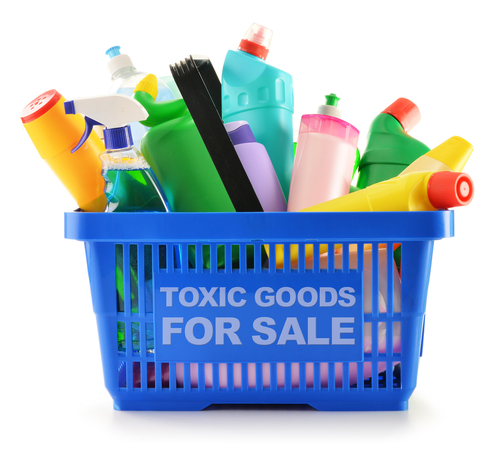Endocrine disruptors, those little nasty chemicals found all around us…. in our food, carpeting, paint, baby toys…. literally everywhere, can wreak absolute havoc on our reproduction systems as well as our neurological and immune systems.
You may remember from our last blog post that endocrine disruptors affect our health in a few different ways:
- The disruptors have the ability to mimic (or partly mimic) our naturally occurring hormones like estrogens, androgens and thyroid hormones which causes a potential overstimulation.
- Another way these disruptors disrupt is to bind to a receptor within a cell and block the real hormones from binding. This causes problems because normal signals fail to happen and so the body fails to respond properly.
- Endocrine disruptors may also interfere with how natural hormones or their receptors are made or controlled. For instance, they can alter metabolism in our liver.
In 2013, the World Health Organization (WHO) and the United Nations Environment Program (UNEP) conducted a joint study and released their findings in what is considered one of the most comprehensive reports on endocrine-disrupting chemicals to date. Their report concluded a wide variety of health issues can be linked to endocrine disruptor exposure.
According to their report:
“The diverse systems affected by endocrine-disrupting chemicals likely include all hormonal systems and range from those controlling development and function of reproductive organs to the tissues and organs regulating metabolism and satiety.
Effects on these systems can lead to obesity, infertility or reduced fertility, learning and memory difficulties, adult-onset diabetes or cardiovascular disease, as well as a variety of other diseases.”
And, in case you’re wondering, endocrine disruptors affect men’s health as well. In fact new studies are revealing that these harmful chemicals may be causing physical feminization in male infants. A study published by the International Journal of Andrology found that feminization of boys can now be seen through their play habits.
And medical experts are now wondering whether exposure to these toxic chemicals for years isn’t the reason so many older men are low on testosterone and experiencing erectile dysfunction.
The truth is, no one is safe from the effects of endocrine disruptors, not babies, not the elderly, not men or women. But, by making some lifestyle changes you can make more educated purchasing choices and avoid these chemicals as much as humanly possible.
10 Common Sources of Endocrine-Disrupting Chemicals
It may shock you to learn just how often you are exposed to these toxic chemicals. In fact, Thomas Zoeller, a biology professor at the University of Massachusetts Amherst, estimates there are between 800-1,000 endocrine-disrupting chemicals currently on the market.
1. Personal Care Products
Phthalates are a group of “gender-bending” chemicals causing males of many species to become more female. You may have read in our last blog post that scientists have found male fish who are now growing eggs in their testes. Phthalates have also been shown to cause testicular cancer, low sperm counts, genital deformations and infertility.
Phthalates can be found in shampoos, conditioners, soaps, moisturizers and other personal care products. In 2002 the Environmental Working Group detected phthalates in over half of personal care products tested. They concluded:
“Major loopholes in federal law allow the… cosmetics industry to put unlimited amounts of phthalates into many personal care products with no required testing, no required monitoring of health effects, and no required labeling.”
To avoid this toxic exposure, look for personal care products that are 100% organic.
2. Drinking Water
Whether your source for water is your city or your own personal well, your drinking water may be contaminated with chemicals such as atrazine, arsenic, and perchlorate, all of which can disrupt your endocrine system. We recommend you use a high-quality water filtration system both for your tap water and your shower/bath water.
(Editor’s note: Try >this amazing new invention<, you’ll never have to drink contaminated water again!)
3. Canned Foods
It has been known for quite a few years now that bisphenol-A (BPA) is an endocrine disruptor, and yet in a recent analysis if 252 canned food brands, 78 were found to still be using BPA. BPA coats about 75% of cans in North America so if you ever eat canned food, as most of us do, you are being exposed to this toxic chemical.
BPA is linked to numerous health concerns such as structural damage in the brain, impaired learning, altered immune function, increased prostate size and decreased sperm production. If you can, buy products that come in glass bottles or jars.
4. Conventionally Grown Produce
You’re most likely not shocked at this one and have known about the pesticides, herbicides, and industrial runoff that contaminates many of our conventionally grown fruits and veggies. Depending on where in the country you live, it may not always be easy or it may be quite expensive, but as much as you can, buy and eat organic produce to reduce your exposure to these toxic chemicals.
5. CAFO Meat, Poultry, and Dairy Products
Animals raised on concentrated animal feeding operations (CAFOs) have usually been given antibiotics and hormones, as well as other nasty industrial chemicals that have the ability to disrupt your endocrine system. When shopping, always look for animal products that are organic, free-range, and if possible, raised on small, local farms.
6. High-Mercury Fish
It’s not only pregnant women who have to be mindful of not eating fish with high levels of mercury, all of us need to stay away from mercury and other heavy metals because they can disrupt our hormone balance. Some fish that are the worst offenders are marlin, shark, swordfish and king mackerel, and even tuna has been known to have dangerously high levels of metals. And don’t assume farmed fish are any safer as they also tend to have more contaminants than you would imagine and should be avoided. Your best bet is to stick to the smaller fish like anchovies, sardines and herring which are low in contaminants and high in omega-3 fats. A win/win.
(Editor’s note: Omega-3 is without-a-doubt one of the most beneficial nutrients on the planet – and we’ve found the purest, most concentrated form available >Click Here to try it FOR FREE<)
7. Kitchenware
There are no doubt dangers lurking in your kitchen right now. Plastic containers and non-stick cookware contain BPA and other endocrine-disrupting chemicals, and these can leach into your food, especially if the plastic is heated. Non-stick cookware releases perfluorooctanoic acid (PFOA) which has been linked to infertility, thyroid disease and reproductive disorders.
Safer options include ceramic and enameled cast iron cookware. These are durable, easy to clean and completely inert, which means they won’t release any harmful chemicals that can cause you physical harm.
8. Cleaning Products
Your home is also most likely filled with cleaning products that contain chemicals known to cause endocrine disruptions. Your options are to use 100% natural and organic products or make your own, which is quite simple. You can simply use combinations of vinegar, baking soda and essential oils.
9. Office Products
There are many chemicals lurking in office environments such as toner and ink cartridges that are known endocrine disruptors. You should minimize your exposure to these as much as possible and always handle with care.
10. Cash Register Receipts
When the cashier asks if you’d like your receipt, better to say no. Thermal paper has a special coating that turns black when it is heated and this coating contains BPA. A study in the journal Analytical and Bioanalytical Chemistry found that 11 out of the 13 thermal papers on the market all contain BPA, and simply handling these papers is enough to raise these levels in the body.
If you’re confused and frustrated as to why these everyday objects aren’t being decontaminated from BPA and other Endocrine Disruptors… trust me, you’re not alone. There are various groups lobbying against the use of these Endocrine Disruptors, which are CLEARLY harmful for human beings.
But until “the powers that be” wake up and actually do something about this critical issue – we will have to be extra careful and do our best to avoid these culprits of Endocrine Disruptors.
 Validating...
Validating... 





Leave a Reply